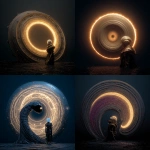Explore the Best AI Image Gallery

Bridging the Gap: How Wearable Tech is Redefining Creative Expression
The realm of creativity has undergone a seismic shift with the advent of wearable technology. Artists, designers, and innovators are now equipped with an unprecedented array of tools to augment their creative processes, blurring the lines between the physical and digital worlds. From interactive installations to personalized artistic experiences, wearable tech is redefining how we create, consume, and interact with art.
Wearable Tech: A New Canvas for Artistic Expression
Wearables provide artists with a unique platform to transcend traditional mediums. Imagine a dancer whose movements trigger projections on the stage, or a musician who controls sound by manipulating gestures with their smart gloves. These are just glimpses into the boundless possibilities that wearable tech offers:
- Interactive Installations: Wearables can transform static art pieces into dynamic experiences. Visitors wearing sensors might influence light patterns, soundscapes, or even the physical structure of an installation, becoming active participants in the artwork.
- Personalized Artistic Experiences: Imagine attending a concert where the music adapts to your emotions, detected through wearable bio-sensors. Or picture a museum exhibit where artifacts come to life based on your gaze and movements, creating a tailored narrative for each visitor.
- Body as a Medium: Wearables can extend the bodys capabilities, allowing artists to express themselves through light shows, kinetic sculptures, or even interactive tattoos that react to touch or sound.
The Ethical Landscape of Wearable Creativity
As with any powerful technology, wearable tech in creative contexts raises important ethical considerations:
- Data Privacy: Wearables collect vast amounts of personal data. It is crucial to ensure transparency and user consent regarding the collection, storage, and use of this information.
- Bias and Representation: AI algorithms used in wearable tech can perpetuate existing biases if not carefully developed and monitored. It is essential to strive for inclusive and diverse datasets to avoid reinforcing harmful stereotypes.
- Accessibility and Equity: The cost and availability of wearable technology can create disparities in access to creative opportunities. Efforts should be made to ensure that these tools are accessible to all individuals, regardless of their socioeconomic background.
Future Trends: Shaping the Creative Landscape
The intersection of wearable tech and creativity is constantly evolving. Here are some emerging trends that hold immense potential:
- Immersive Experiences: Wearables will increasingly integrate with augmented and virtual reality, creating captivating immersive experiences that blur the boundaries between the real and the digital.
- AI-Powered Creativity: AI algorithms will play an increasingly prominent role in assisting artists, generating new ideas, and personalizing creative outputs.
- Decentralized Creativity: Blockchain technology could empower artists by enabling direct connections with audiences, facilitating peer-to-peer transactions, and ensuring fair compensation for their work.
Wearable technology is not simply a tool; it is a catalyst for transformation. It empowers us to explore new frontiers of creative expression, fostering collaboration, innovation, and a deeper understanding of the human experience. As we navigate this exciting frontier, it is essential to embrace ethical considerations, promote inclusivity, and ensure that wearable tech serves as a force for positive change in the world.
















](https://images.ai-img.art/thumbnails/150/62dee1effeb677492e9eb31757a5d6c9ea9f1010c26733e1980579df8e9fe333.webp)







